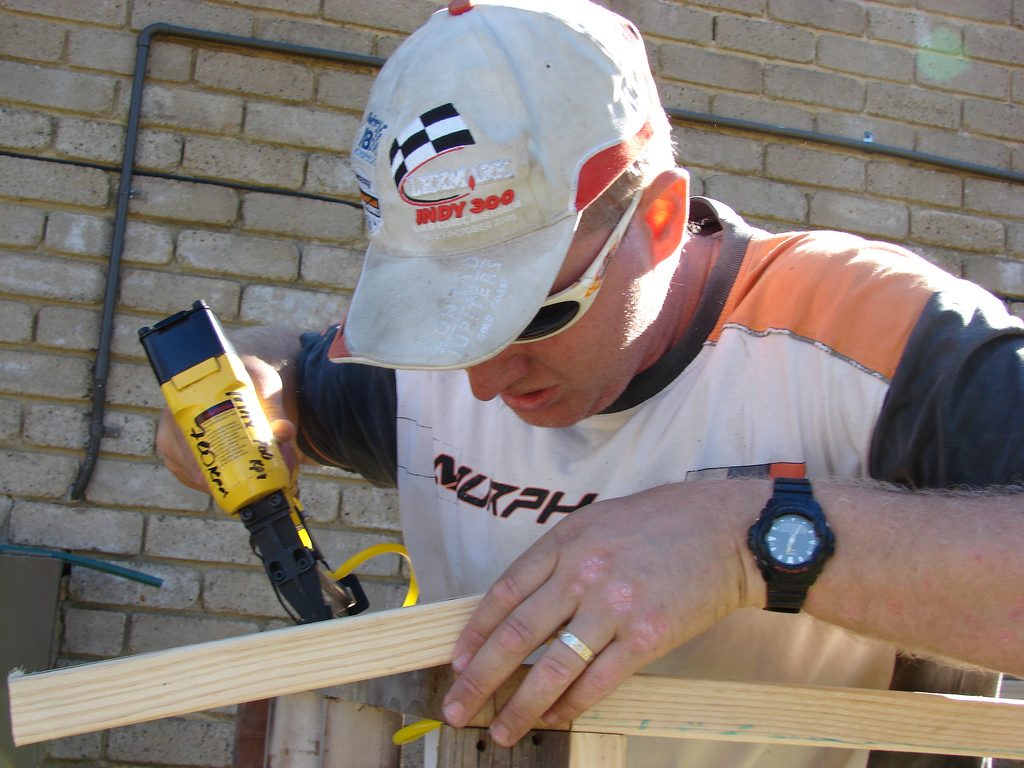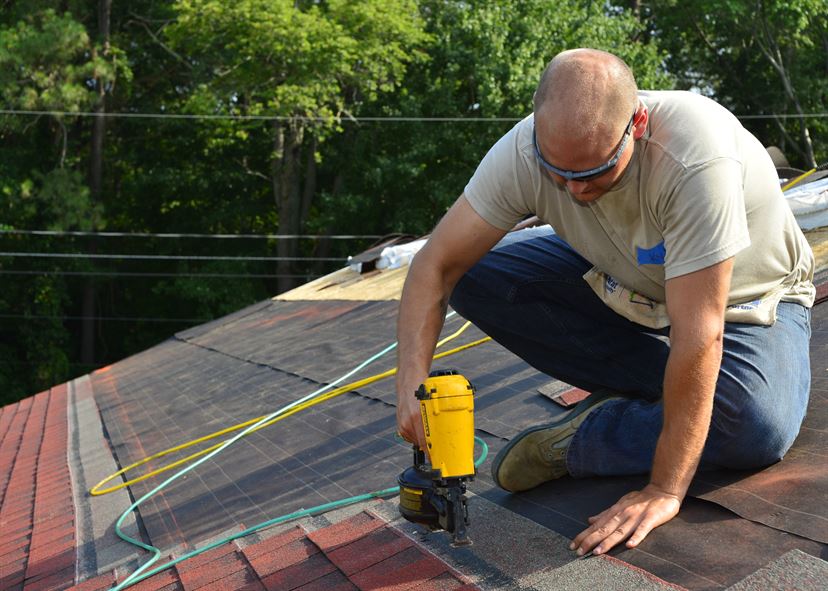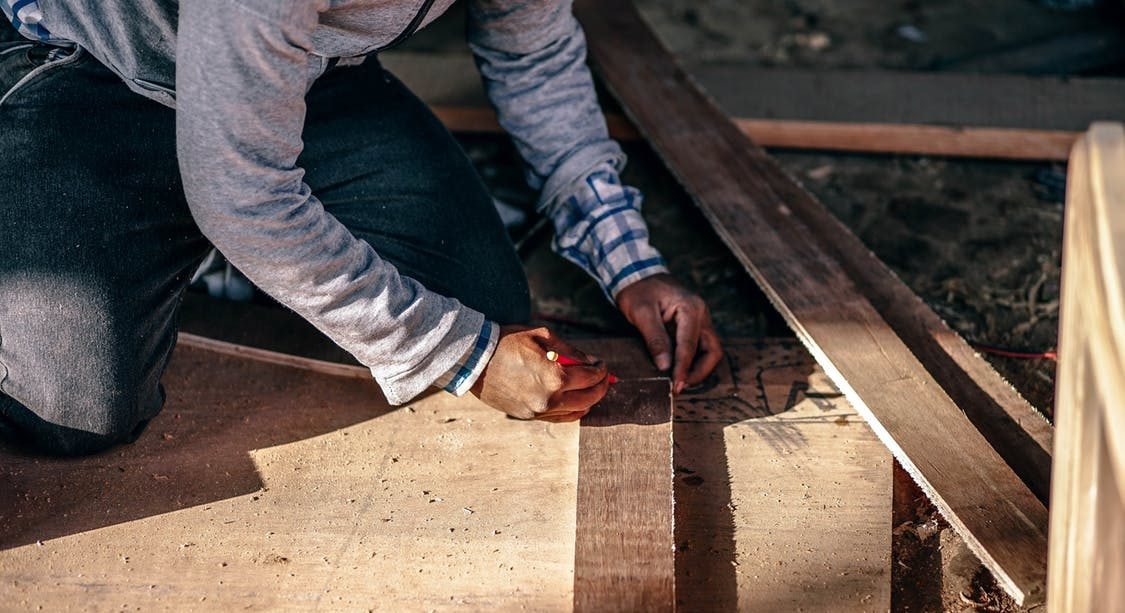A brad nailer is a lightweight power tool that fire small 18 gauge nails that are notoriously hard to hammer into wood by hand. The two main types of brad nailer include a pneumatic or electric version where both have their own benefits.
The best brad nailer is the DEWALT DC608K Kit. The DC608K Kit accepts 18 gauge nails that range from 5/8 inch to 2 inches in length for compatibility with all woodworking jobs.
For affixing low density materials such as plywood and other decorative materials, the brad nailer is the go to power tool. If you are fed up of hitting your hand with the hammer whilst hitting 18 gauge nails, the brad nailer will improve your woodworking.
Table of Contents
Best 18 Gauge Brad Nailers
| Brad Nailer | Type | Weight |
|---|---|---|
| DEWALT DC608K | Cordless | 7.4 LBS |
| BOSTITCH BTFP1KIT | Pneumatic | 2.7 LBS |
| Hitachi NT50AE2 | Pneumatic | 2.2 LBS |
| Makita AF505N | Pneumatic | 3.0 LBS |
| PORTER-CABLE PCC790LA | Cordless | 5.9 LBS |
Pneumatic nail guns are powered by an air compressor and provide a constant force and do not need recharging. This is perfect for a professional that already owns an air compressor. However, the average DIY’er will more than likely suit an electric brad nailer for ease of use and cost effectiveness.
The magazine of the brad nailer also requires consideration as you are able to use a stick or coil magazine. Also, the latter being able to hold more nails. A coil magazine is the more desirable as it prevents the need to reload as often.
Using a power tool over your hand and hammer is highly recommended to improve your work rate and efficiency. Below is a list of the best brad nailers for woodworking with the choice of both electric and pneumatic tools.
DEWALT DC608K 18-Gauge Brad Nailer Kit
The DC608K is Dewalt’s answer to a premium electric brad nailer that provides consistent nail penetration into both soft and hard joints. It accept 18 gauge nails that range from 5/8 inch to 2 inches in length, which is ideal for most woodworking jobs.
It is a cordless brad nailer with various modes for particular woodworking activities. The most prominent mode is the sequential operation. It allows for precision placement of the nail but there are many more modes to choose from.
As its cordless, it will require charging but the 18V NiCAD battery will fully recharge in just 1 hour and be able to shoot 1,000 nails per charge.
Overall, it is the best cordless brand nailer with an excellent battery and plenty of functionality. The only drawback is that it is slightly heavy at 7.4 LBS but its easy to carry with the ergonomic handle for portability.
Check it OutBOSTITCH BTFP1KIT & Compressor Combo Kit
Bostitch is a brand that are known for their high quality power tools and in particular their brad nailers and compressors. This particular kit comes in either a one, two or three tool and compressor kit that will fit the needs of all professional carpenters.
The 18 gauge brad nailer weighs 2.7 LBS and works with lengths ranging from 5/8 inch to 2 inches. These are then delivered at 90 PSI to the material. In terms of the noise levels, it is fairly quiet at just 78.5 dBa.
In terms of the air compressor that is used to power up the brad nailer, it is has a maximum rating of 150 PSI from the 6 gallon tank. The nailer then connects via a high quality 1/4″ x 25′ PVC air hose with fittings.
Overall, the BOSTITCH BTFP1KIT & Compressor Combo Kit offers excellent value for money. This considering you get the compressor and brad nailer. It is the best pneumatic brad nailer for the money and the matching BOSTITCH air compressor makes the setup hassle-free.
Check it OutHitachi NT50AE2 18-Gauge Brad Nailer
If you already have an air compressor and want just the bare tool to use, the Hitachi NT50AE2 is ideal. It is one of the lightest at 2.2 LBS and uses a elastomer grip, which is more comfortable on the hand and prevents slippage.
The NT50AE2 is a pneumatic brad nailer that has dual firing options for precise or continuous driving. These are simple to activate with a single control button. You can even adjust the depth of the drive for additional accuracy.
The Hitachi NT50AE2 has been designed for comfort with the lightness and ergonomic handle. It is the best cheap brad nailer that offers excellent value for money and has the performance of alternatives that are twice the price.
Check it OutMakita AF505N Brad Nailer
Another pneumatic brad nailer that is worthy of a mention if the AF505N model by Makita. It is a reasonably priced alternative to the Hitachi and Bostitch alternatives but with a few quirks that make it more unique.
Other useful features include the adjustable depth that can be adjusted via an easy to use dial and without any tools. The tool hook can also be rotated 180 degrees, which with the narrow nose design means you are able to drive a nail in tight positions.
It will drive a range of 18 gauge brad nails from 5/8 inch to 2 inches where each magazine holds up to 100 nails. The Makita AF505N can be used for a wide variety of woodworking and weighs just 3 LBS, which is relatively lightweight.
Check it OutPORTER-CABLE PCC790LA Cordless Brad Nailer
If the Dewalt electric brad nailer is too expensive, Porter Cable offer the PCC790LA model that has very similar functionality and performance to the Dewalt alternative.
It uses the a 1.5 Ah 20V MAX Lithium-ion battery that is capable of 1,300 brad nail per charge. While it weighs just 5.9 LBS. These are both better stats than the DC608K but at a much lower price by the Porter Cable PCC790LA.
Overall, it offers outstanding value for money and is the best cheap cordless brad nailer you can buy. It lacks a few of the features compared to the more expensive Dewalt model but the lightness, battery and cheaper cost of the tool may sway your decision to purchasing this PCC790LA brad nailer.
Check it OutBrad Nailer Buying Guide
Brad nailers and nailers in general exist to affix one object to another. This by using a kinetically launched nail, or fastener and the process can take less than a second to complete. Nailers are used to connect trim work to walls, or to connect paneling to a surface. They are also used to connect sections of wood together, though their potential uses can be expanded greatly beyond the aforementioned work projects.
If a project requires that two surfaces be permanently affixed to one another, that project can usually be satisfied by a nailer. Vital to the value of a nailer is its ability to drive nails into a surface from any angle. Whether the user is standing upright or hanging upside-down, a good nailer can fasten two surfaces together with minimal effort.
However, not all nailers fill the same roles. Some nailers fire stronger, thicker fasteners. Some fire weak, but low-profile, fasteners. Other nailers seek to achieve an adequately strong hold between two surfaces while maintaining the visual fidelity of the surface on which the tool is used.
The more powerful framing nailer is one of these other nailers that deliver a more powerful drive and are often sold as a package along with a brad nailer. If you are yet to have either, this may be a great option and a worthwhile investment.
Nailer Specifications
Nailers are tools designed to be held in one hand, thus freeing up the other hand to hold the object being fastened in place. There is a trigger located near the top of the tools grip that aligns with the index and middle fingers.
When the trigger is pulled, it engages the firing action of the nailer. Ideally, a nailer will be heavy enough to absorb any unwieldy recoil from the nail’s initial launch, while being light enough for the user to hold the tool comfortably. Perhaps even more ideally, the nailer will be safe to use without any of the safety features slowing the user’s work progress.
Safety Features
Any tool that uses a large amount of rapidly-exerted kinetic energy to function will also necessarily require certain safety features. Most modern nailers will have a contact safety tip the front nose of the nailer must be depressed onto its intended surface before the nailer will launch a fastener.
Some contact safety tips may be harder or easier to depress. The user may wish to experiment with different safeties to find the nailer that best satisfies their preference. Nailers can be perfectly safe tools given that the tool-wielder takes every necessary safety measure while they work.

Nails and Nail Gauge
The nails used in nailers are measured according to gauge. Originally, gauge referred to the diameter of a certain size of wire per inch. If a wire was 15-gauge, it meant that 15 wire-diameters placed side by side were needed. This to reach one inch of space. In nailer terms, the diameter is still measured according to the amount of wires per inch. However, the diameter was translated to be comparable to the size of the nails.
It’s important to understand that the gauge and the size of the nails are inversely proportional. A smaller gauge will mean larger nails. A larger gauge will mean smaller nails. Smaller gauges are used for heavier projects. Larger gauges are used for lighter projects.
Nails are stored in a compartment located near the front of the nailer, called the magazine. A spring-loaded platform loads each nail to the nose of the nailer. Smaller gauge nails are vertically stacked. Larger gauge-nails, for 15-gauge and 16-gauge nailers, are typically diagonally stacked. Because the nails are quite long, a rearward diagonal tilt in the magazine is necessary. This is done to make larger nailers as compact as possible, allowing the user to adjust the angle of the nose of the nailer with a relatively modest amount of freedom.
Brad Nailer Use
Brad nailers a kind of nailer firing 18-gauge nails called “brads” are used for thinner or more narrow projects that require a low-profile finish. The brad nailer is useful for adding trim to the walls of a home, or for adding borders to a window, or for attaching baseboards to a wall, or for any other number of similar DIY projects that require low-profile nailing.
The smaller nails, which usually measure to be about two inches long do not split thinner wooden trims or molds. They are not only safer to use on such surfaces, they also do not leave as much visible damage to the surface into which the nails were dispatched.
Brad nailers can make projects involving medium-to-light components or materials quick and efficient, though the brads may not be strong enough to adequately fasten exceptionally heavy project materials.
It is also highly pertinent to note that brad nails might actually be slightly longer than two inches. The length difference can be traced to any number of reasons, such as different machining processes at different companies, or different dimension specifications for different nailers. For that reason, it is important to search for a brad nailer that accommodates nails slightly longer than two inches.
Brad Nailers Compared to Pin Nailers
The pin nailer fills roles that require even lesser amounts of force than the already low-profile brad nailer. Pin nailers use very fine 23-gauge nails that make a nearly imperceptible impact on their target surfaces.
These fine nails are needed for sensitive jobs that heavier nailers might botch. Wooden trims or moldings made from weak, soft materials might break under the wider area of impact created by stronger nailing equipment. However, because pin nailers are intended for lighter, more specialized work, they are even less likely to securely bind heavier surfaces together.
Brad Nailers Compared to Finish Nailers
The larger 15 or 16 gauge finish nailer, function similar to both pin nailers and brad nailers, fire stronger and larger nails than their aforementioned relatives. Finish nailers fire fifteen-gauge and sixteen-gauge fasteners into a project surface.
The tool uses nails that are slightly longer and thicker than the brads used by brad nailers they are usually between two to two and one-half inches in length. Thicker, weightier work surfaces, such as heavy moldings or strong door frames, require stronger tools.
For this reason, finish nailers are typically employed to satisfy projects that deal with heavier components or materials. However, a larger nail means a larger risk of damaging or splintering more delicate surfaces.

Power and Safety
A brad nailer should be powerful enough to pierce its target surface. However, it must not over-penetrate all the way through and far behind its intended surface. Most brad nailers work with an operating pressure of 70 to 120 PSI.
The user must accept a certain amount of responsibility when using a brad nailer; they must be fully cognizant not only of what they intend to nail, but also of what lies behind what they intend to nail.
Though it is pertinent that the user fully take every safety precaution when dealing with highly-pressurized nailing equipment, the equipment itself should also be trustworthy and safe. For this reason, the user should also strive find buy a brad nailer with a record of safety and functional reliability.
Comfort
The user must also make sure to find the most comfortable grip. While having a good grip angle when looking for a brad nailer. Grips with good traction can prevent any accidental slips. It also prevent any brads from entering any unwanted surfaces especially human flesh.
A nailer that works in harmony with the user’s wrist and palm can help to considerably simplify a project.
Further, a worker will be much safer using a comfortable tool they may be less likely to drop their equipment, or to injure themselves while adjusting their grip.
Weight
Weight is another essential consideration in finding the ideal nailer. Some nailers may contain heavier components. A decent weight may help with absorbing recoil. But if a nailer is too heavy, the user may have to fight discomfort. Further, it may be more difficult for the user to transport a heavy nailer to and from each work location.
Though each make of brad nailer will be different in its features, and though each user may place more value on a certain nailer feature over another, brad nailers that can combine the ideal amount of power, comfort, and mobility can help to streamline any work project that requires their operation.
Combustion Brad Nailers
Combustion nailers nailers that fully earn the nickname “nailgun” use cartridge-based blanks to launch nails. Such nailers use rimfire .22 caliber blank ammunition to fasten two surfaces together. These nailers function similarly to actual guns.
The pressure created from the blank propels the nail out of the tool. Such nailers are highly mobile, powerful, and use up a minimal amount of space. However, they can also make a project more expensive. The user has to consider the cost of the blank ammunition in conjunction with the cost of other materials.
Electric Brad Nailers
Electric nailers use electromagnetic force to drive a nail into a target surface. These electric nailers may or may not have great mobility, depending on their source of power. A battery-powered nailer may provide incredible mobility, at the cost of reliability. The nailer will effectively be out of commission if there is not an ample supply of charged battery packs. A cord-powered nailer will be as reliable as the outlet into which it is plugged. However, it will also be limited to only work areas that have readily available outlets. If a user chooses a corded or battery-powered electric nailer, they must pay attention to any work environment issues such as a lack of power sources that may cause their nailer’s usability to diminish.
Pneumatic Brad Nailers
Pneumatic nailers use compressed air to launch nails. They are somewhat similar to combustion nailers, in that they use pressurized gases to launch their fasteners. An electrically powered air-compressor fills a pressurized chamber with air. When the user engages the nailer, the chamber opens, and the resulting pressure release ejects the nail. Pneumatic nailers try to combine mobility and reliability.
Most pneumatic nailers offer portable airtanks that can filled by the compressor and moved to a project location. Though pneumatic nailers might be theoretically mobile, in practice, the user must still transport bulky air tanks and air tank compression equipment to the project location. If a user intends to only bring the nailer and a compressor to a job, bringing no extra air supplies, they might face the same mobility issues of a corded or battery-powered electric nailer.
Most of these problems will more than likely never happen. The most workplaces will have a reliable source of power. And most users will probably be able to devise ways to circumvent any mobility issues. However, a user will always benefit from understanding the limitations of his or her tools.
Conclusion
The ideal brad nailer offers an adequate amount of functional strength while protecting the visual consistency of a construction project. It will not leave a project with splits or splinters. It should leave a work project with a uniform appearance and secure hold.
Ironically, the best brad nailer will not leave any evidence of its use. The ideal brad nailer is comfortable and reasonably safe. Also, it is able to work in a diverse series of locations and circumstances.






